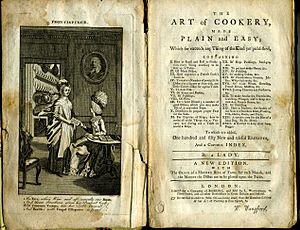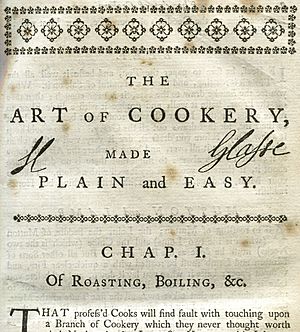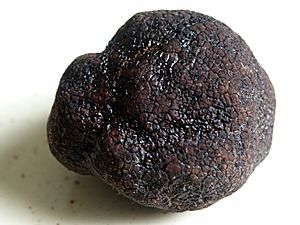The Art of Cookery Made Plain and Easy facts for kids

Frontispiece and title page in an early posthumous edition, published by L. Wangford, c. 1777
|
|
| Author | "By a LADY" (Hannah Glasse) |
|---|---|
| Country | England |
| Language | English |
| Subject | English cooking |
| Genre | Cookbook |
| Publisher | Hannah Glasse |
|
Publication date
|
1747 |
| Pages | 384 |
The Art of Cookery Made Plain and Easy is a cookbook by Hannah Glasse (1708–1770) first published in 1747. It was a bestseller for a century after its first publication, dominating the English-speaking market and making Glasse one of the most famous cookbook authors of her time. The book ran through at least 40 editions, many of which were copied without explicit author consent. It was published in Dublin from 1748, and in America from 1805.
Glasse said in her note "To the Reader" that she used plain language so that servants would be able to understand it.
The 1751 edition was the first book to mention trifle with jelly as an ingredient; the 1758 edition gave the first mention of "Hamburgh sausages" and piccalilli, while the 1774 edition of the book included one of the first recipes in English for an Indian-style curry. Glasse criticised French influence of British cuisine, but included dishes with French names and French influence in the book. Other recipes use imported ingredients including cocoa, cinnamon, nutmeg, pistachios and musk.
The book was popular in the Thirteen Colonies of America, and its appeal survived the American War of Independence, with copies being owned by Benjamin Franklin, Thomas Jefferson and George Washington.
Book
The Art of Cookery was the dominant reference for home cooks in much of the English-speaking world in the second half of the 18th century and the early 19th century, and it is still used as a reference for food research and historical reconstruction. The book was updated significantly both during her life and after her death.

Early editions were not illustrated. Some posthumous editions include a decorative frontispiece, with the caption
The FAIR, who's Wise and oft consults our BOOK,
And thence directions gives her Prudent Cook,
With CHOICEST VIANDS, has her Table Crown'd,
And Health, with Frugal Ellegance is found.
Some of the recipes were plagiarised, to the extent of being reproduced verbatim from earlier books by other writers. To guard against plagiarism, the title page of, for example, the sixth edition (1758) carries at its foot the warning "This BOOK is published with his MAJESTY's Royal Licence; and whoever prints it, or any Part of it, will be prosecuted". In addition, the first page of the main text is signed in ink by the author.
The first edition of the book was published by Glasse herself, funded by subscription, and sold (to non-subscribers) at Mrs. Ashburn's China Shop.
Contents
- Chapter 1: Of Roasting, Boiling, &c.
- Chapter 2: Made Dishes.
- Chapter 3: Read this Chapter, and you will find how expensive a French Cook's Sauce is.
- Chapter 4: To make a Number of pretty little Dishes fit for a Supper, or Side-Dish, and little Corner-Dishes for a Great Table; and the rest you have in the Chapter for Lent.
- Chapter 5: Of Dressing Fish.
- Chapter 6: Of Soops and Broths.
- Chapter 7: Of Puddings.
- Chapter 8: Of Pies.
- Chapter 9: For a Fast-Dinner, a Number of good Dishes, which you may make use of for a Table at any other Time.
- Chapter 10: Directions for the Sick.
- Chapter 11: For Captains of Ships.
- Chapter 12: Of Hogs Puddings, Sausages, &c.
- Chapter 13: To pot and make Hams, &c.
- Chapter 14: Of Pickling.
- Chapter 15: Of making Cakes, &c.
- Chapter 16: Of Cheesecakes, Creams, Jellies, Whipt Syllabubs, &c.
- Chapter 17: Of Made Wines, Brewing, French Bread, Muffins, &c.
- Chapter 18: Jarring Cherries, and Preserves, &c.
- Chapter 19: To make Anchovies, Vermicella, Catchup, Vinegar; and to keep Artichokes, French Beans, &c.
- Chapter 20: Of Distilling.
- Chapter 21: How to market, and the Seasons of the Year for Butchers Meat, Poultry, Fish, Herbs, Roots, &c and Fruit.
- Chapter 22: [Against pests]
- Additions
- Contents of the Appendix.
Approach
To make a trifle.
COVER the bottom of your dish or bowl with Naples biscuits broke in pieces, mackeroons broke in halves, and ratafia cakes. Just wet them all through with sack, then make a good boiled custard not too thick, and when cold pour it over it, then put a syllabub over that. You may garnish it with ratafia cakes, currant jelly, and flowers.
The book has a brief table of contents on the title page, followed by a note "To the Reader", and then a full list of contents, by chapter, naming every recipe. There is a full alphabetical index at the back.
Glasse explains in her note "To the Reader" that she has written simply, "for my Intention is to instruct the lower Sort", giving the example of larding a chicken: she does not call for "large Lardoons, they would not know what I meant: But when I say they must lard with little Pieces of Bacon, they know what I mean." And she comments that "the great Cooks have such a high way of expressing themselves, that the poor Girls are at a Loss to know what they mean."
As well as simplicity, to suit her readers in the kitchen, Glasse stresses her aim of economy: "some Things [are] so extravagant, that it would be almost a Shame to make Use of them, when a Dish can be made full as good, or better, without them."
Chapters sometimes begin with a short introduction giving general advice on the topic at hand, such as cooking meat; the recipes occupy the rest of the text. The recipes give no indication of cooking time or oven temperature. There are no separate lists of ingredients: where necessary, the recipes specify quantities directly in the instructions. Many recipes do not mention quantities at all, simply instructing the cook what to do, thus:
Sauce for Larks.
LARKS, roast them, and for Sauce have Crumbs of Bread; done thus: Take a Sauce-pan or Stew-pan and some Butter; when melted, have a good Piece of Crumb of Bread, and rub it in a clean Cloth to Crumbs, then throw it into your Pan; keep stirring them about till they are Brown, then throw them into a Sieve to drain, and lay them round your Larks.
Foreign ingredients and recipes

Glasse set out her somewhat critical views of French cuisine in the book's introduction: "I have indeed given some of my Dishes French Names to distinguish them, because they are known by those names; And where there is great Variety of Dishes, and a large Table to cover, so there must be Variety of Names for them; and it matters not whether they be called by a French, Dutch, or English Name, so they are good, and done with as little Expence as the Dish will allow of." An example of such a recipe is "To à la Daube Pigeons"; a daube is a rich French meat stew from Provence, traditionally made with beef. Her "A Goose à la Mode" is served in a sauce flavoured with red wine, home-made "Catchup", veal sweetbread, truffles, morels, and (more ordinary) mushrooms. She occasionally uses French ingredients; "To make a rich Cake" includes "half a Pint of right French Brandy", as well as the same amount of "Sack" (Spanish sherry).
Successive editions increased the number of non-English recipes, adding German, Dutch, Indian, Italian, West Indian and American cuisines. The recipe for "Elder-Shoots, in Imitation of Bamboo" makes use of a homely ingredient to substitute for a foreign one that English travellers had encountered in the Far East. The same recipe also calls for a variety of imported spices to flavour the pickle: "an Ounce of white or red Pepper, an Ounce of Ginger sliced, a little Mace, and a few Corns of Jamaica Pepper."
Legacy
Ian Mayes, writing in The Guardian, quotes Brewer's Dictionary of Phrase and Fable as stating "First catch your hare. This direction is generally attributed to Hannah Glasse, habit-maker to the Prince of Wales, and author of The Art of Cookery made Plain and Easy". Her actual directions are, 'Take your Hare when it is cas'd, and make a pudding...' To 'case' means to take off the skin" [not "to catch"]; Mayes notes further that both the Oxford English Dictionary and The Dictionary of National Biography discuss the attribution.
As at 2015[update], Scott Herritt's "South End" restaurant in South Kensington, London, serves some recipes from the book. The "Nourished Kitchen" website describes the effort required to translate Glasse's 18th-century recipes into modern cooking techniques.
Editions
The book ran through many editions, including:
- First edition, London: Printed for the author, 1747.
- London: Printed for the author, 1748.
- Dublin: E. & J. Exshaw, 1748.
- London: Printed for the author, 1751.
- London: Printed for the author, 1755.
- Sixth edition, London: Printed for the author, sold by A. Millar, & T. Trye, 1758.
- London: A. Millar, J. and R. Tonson, W. Strahan, P. Davey and B. Law, 1760.
- London: A. Millar, J. and R. Tonson, W. Strahan, T. Caslon, B. Law, and A. Hamilton, 1763.
- Dublin: E. & J. Exshaw, 1762.
- Dublin: E. & J. Exshaw, 1764.
- London: A. Millar, J. and R. Tonson, W. Strahan, T. Caslon, T. Durham, and W. Nicoll, 1765.
- London: W. Strahan and 30 others, 1770.
- London: J. Cooke, 1772.
- Dublin: J. Exshaw, 1773.
- Edinburgh: Alexander Donaldson, 1774.
- London: W. Strahan and others, 1774.
- London: L. Wangford, c. 1775.
- London: W. Strahan and others, 1778.
- London: W. Strahan and 25 others, 1784.
- London: J. Rivington and others, 1788.
- Dublin: W. Gilbert, 1791.
- London: T. Longman and others, 1796.
- Dublin: W. Gilbert, 1796.
- Dublin: W. Gilbert, 1799.
- London: J. Johnson and 23 others, 1803.
- Alexandria, Virginia: Cottom and Stewart, 1805.
- Alexandria, Virginia: Cottom and Stewart, 1812.
- London: H. Quelch, 1828.
- London: Orlando Hodgson, 1836.
- London: J.S. Pratt, 1843.
- Aberdeen: G. Clark & Son, 1846.
- The art of cookery, made plain and easy to the understanding of every housekeeper, cook, and servant. With John Farley. Philadelphia: Franklin Court, 1978.
- "First catch your hare--" : the art of cookery made plain and easy. With Jennifer Stead, Priscilla Bain. London: Prospect, 1983.
-
- --- Totnes: Prospect, 2004.
- Alexandria, Virginia: Applewood Books, 1997.
- Farmington Hill, Michigan: Thomson Gale, 2005.
- Mineola, New York: Dover Publications, 2015.
See also
 In Spanish: Art of Cookery para niños
In Spanish: Art of Cookery para niños

